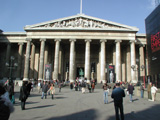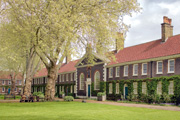London Underground Art: A Remarkable Heritage
Originally published in January 2007 in American in Britain Magazine
London Transport enjoys a unique artistic heritage. As we move into 2007, it is appropriate to celebrate this incomparable service and explore aspects of London Transport’s design history.
London Transport enjoys a unique artistic heritage. For more than one hundred years, Londoners have relied on their system of public transport to get them where they want to go – more or less on time. Now, as we move into 2007, it is appropriate to celebrate this incomparable service and explore aspects of London Transport’s design history. In recent months there have been several exhibitions in London dedicated to publicising the decorative features many travellers may take for granted. In the early days Frank Pick (1878-1941) was a pioneer who understood the importance of high standards in commercial and industrial design. He aimed to publicise whatever the city and its growing suburbs had to offer. Pick joined the Underground Group in 1906 and rose to become managing director in 1933. Driven by a passion for excellence in design, he commissioned the best artists and architects of the day and devoted himself to supervising all aspects of Underground design: posters, station architecture, litter bins, textiles for seat upholstery and furniture, as well as the familiar station rondels or nameboards and the Underground tube map. Pick’s legacy is legendary.
Living up to Pick’s standards in design was not easily achieved. While Pick was on board, he approved two of the most famous images which have featured prominently throughout the history of the transport system. They are Edward Johnston’s ubiquitous London Transport red, white and blue rondel (or nameboard) and Harry Beck’s remarkable tube map. Johnston’s 1918 rondel is the solid red circle with the name printed in white on a dark blue enamel bar which lies horizontally across the red circle. Beck’s tube map as we know it today was based on diagrams of electrical circuits and devised in 1933. The Underground tube map was recently voted second in the best British Design competition – losing out to the Concorde. These ubiquitous images follow us around London every day. They are even found on t-shirts, underwear, pencils, erasers, and all manner of London iconography.
The Design Museum, situated on the South Bank at Shad Thames, features some of the most well-known icons from the London Transport system. The current show, ‘Designing Modern Britain’, is well worth a visit. Johnston’s simple rondel design is displayed (see image here) in an enamel sign directing the traveller to the booking office and trains. Inside a huge glass case in the gallery is an Underground platform bench, like the one many of us have sat on at Hammersmith, Earl’s Court or White City stations while waiting for our train. These extraordinarily simple visionary designs are now barely noticed by busy commuters rushing to their destinations. In many ways they illustrate the ‘golden age’ of London Transport in the 1920s and 1930s and anticipate the demand for another ‘golden age’ which the 2012 London Olympics will make on the public transport system.
The new City Hall held a timely exhibit of inter-war London Transport posters in November 2006. City Hall sits just a few steps along from the Design Museum on the South Bank. Entitled ‘Sporting London’, this show presented a stunning selection of original posters from the London Transport Museum archive. Many of the finest artists of their day illustrated how sport and public transport are woven into the social and cultural fabric of the capital. These posters set a gold standard that still holds today. Seen here are two posters from the City Hall exhibit. They capture the popular sporting spirit of these events. ‘Wimbledon On Court’ by Herry Perry, (1933) is as familiar today as it was some seventy years ago. ‘Sporting London’ by Dame Laura Knight (1921) is the main exhibit poster and has an enduring appeal for rugby fans. Knight made variations of this poster, one of which advertised ‘RUGBY at TWICKENHAM by TRAM from Hammersmith or Shepherds Bush.’ As one of the many commissioned artists working for London Transport, Perry produced thirteen posters and forty-one panel poster; Dame Laura Knight, the first woman Royal Academician in 1936, made seven. The posters were hung in a semi-circular gallery and open to the public. Two visitors, shown in the photo here, seem to be delighted with these works of art.
In December 2006 the Piccadilly Line celebrated its centenary. As part of the celebration six panels have been produced, each highlighting a key historical event at famous Piccadilly Line stations. Centenary posters similar to the panels will be displayed in stations from December 2006. To quote the General Manager of the Piccadilly Line: “We just want to say a very happy birthday to a famous Tube line that’s now been at the heart of London’s transport system for a hundred years.” The Piccadilly Line grew rapidly in the 1930s with extensions to South Harrow and Arnos Grove and out to Cockfosters in 1933. With the ever-increasing demand for air travel, the line was extended to Heathrow in 1977 and 1986 and will open in 2008 at Terminal 5. Three cheers and happy birthday to the Piccadilly Line.
‘Come Out To Live, Come In To Play’ is the title of the current exhibition in the Museum of Domestic Design and Architecture (MoDA), at Middlesex University. It tells the story of the relationship between central and suburban London in the inter-war years. The exhibit consists of a selection of outstanding posters designed in this period together with ordinance survey maps and photographs. Between 1921 and 1937 nearly one and a half million people moved to outer London. Commuters travelled from home to work, to leisure, to school and home again mainly on buses and the Underground. Many of the most gifted commercial poster artists of their day worked in Modernist and avant-garde styles then in vogue. Design styles varied: artists were influenced by cubism, futurism, vorticism, and surrealism. A noted art critic writing at the time suggested that by using more advanced styles of art for publicity, and by placing these images in front of the man in the street, a poster could help to influence the taste of people unlikely to ever enter an art gallery.
Several themes are featured in posters of this period at MoDA: the ease of commuting, an idyllic suburban lifestyle, and the cultural attractions of central London such as theatre, ballet, concerts, sporting activities, shopping and dining out. Two signature posters by the gifted graphic artist Paul Nash (1936) are pictured here: Come Out To Live and Come In To Play. The message conveyed is “come out to live” in the new suburbs and “come in to play” by staying on in town after work. Buy a Season Ticket and have the best of both worlds. Also featured in the exhibit are Alan Rogers’ SPEED (1930) and American born Edward McKnight Kauffer’s Play Between 6 and 12 (1930). Stanislaus Longley’s delightful and amusing posters highlight the virtues of relaxing at the THEATRE, mowing the lawn at HOME and the routine of going to the OFFICE (1933). Working in modernist styles, the artists’ visual brief was to encourage the public to recognise the ease with which the cultural attractions of urban London were accessible by public transport. Try to find time to venture out to suburban Middlesex to view this charming exhibition. You will not be disappointed.
There is little doubt that London Underground art from the inter-war years has preserved a remarkable heritage. It is a visual record which captured the social and economic history of urban, suburban, sporting and leisure lifestyles of the period.
********************************************************************
Reference:
Green, Oliver. Underground Art (2001) 2nd edition published by Laurence King
in Association with the London Transport Museum
Dates & Locations to Note:
Design Museum exhibit ‘Designing Modern Britain’ runs until February 25th 2007
Shad Thames, London SE1 2YD
Designmuseum.org
Office: 0870 909 1909
‘Come Out To Live, Come In To Play’ will run until 3rd June 2007
MoDA (Museum of Domestic Design & Architecture) Entrance is Free.
Middlesex University
Cat Hill, Barnet, Hertfordshire EN4 8HT
Telephone: 020 8411 5244
www.moda.mdx.ac.uk
See London Transport Museum – www.ltmuseum.co.uk
London’s Transport Museum Shop
Unit 26
Covent Garden Piazza London WC2E 7BB
Contact Abby Cronin: artsjournalist@abbycronin.co.uk
Website: www.abbycronin.co.uk




